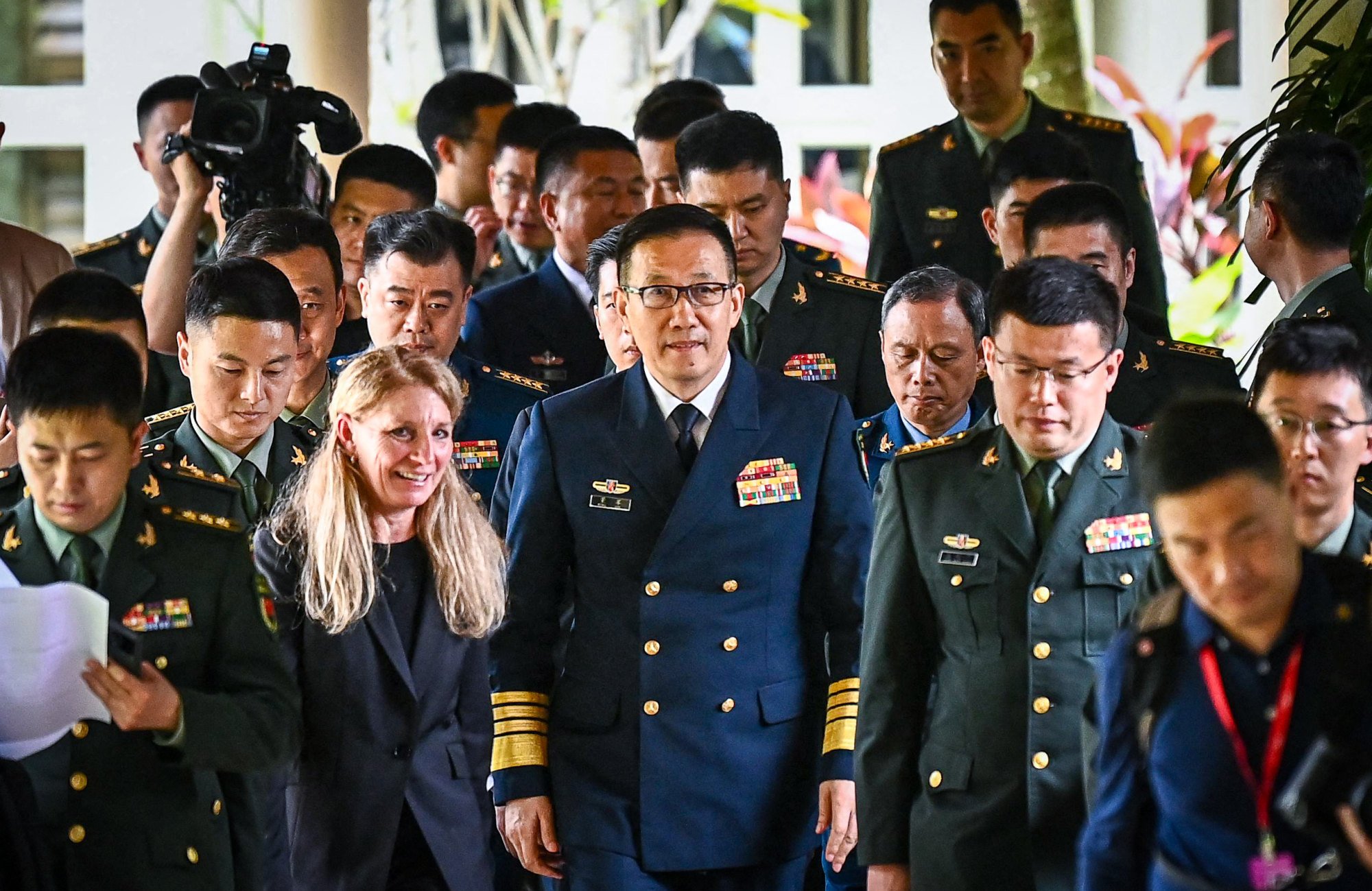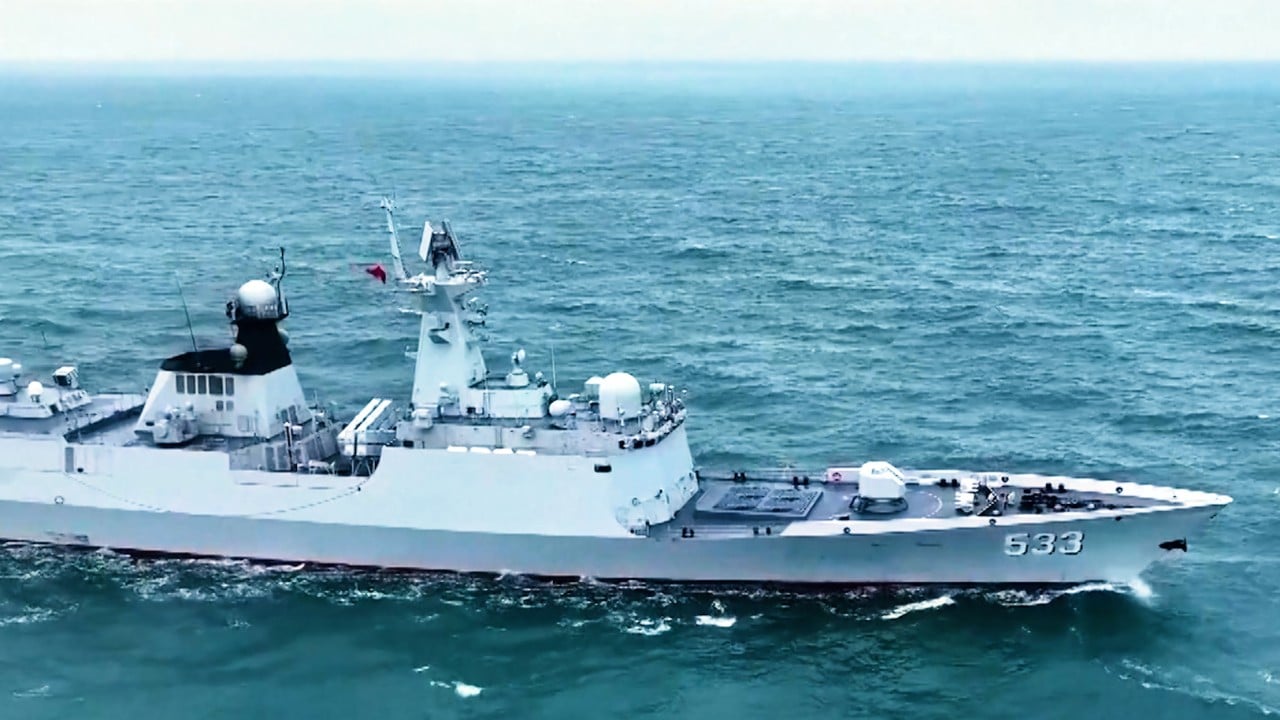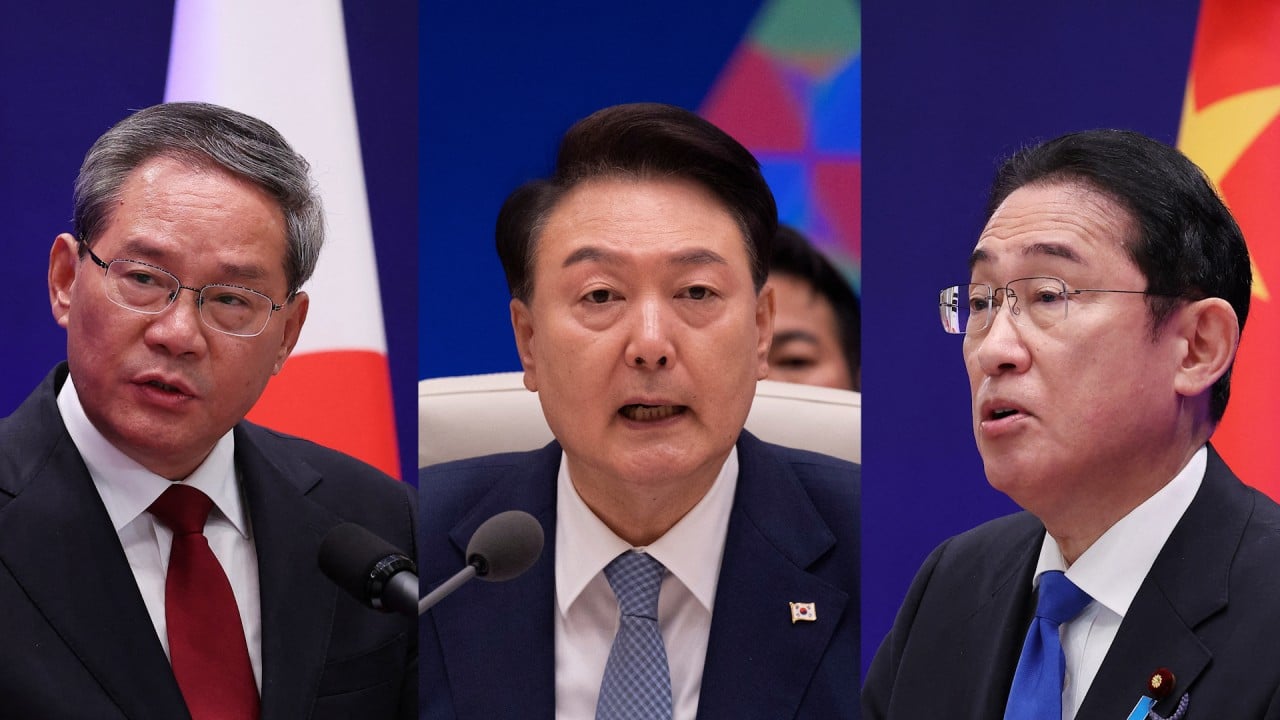This is the third article in a series about China’s military development, from weapons and aircraft to its role in the global supply chain and how it compares with the United States.
While China and the United States work to restore defence communication channels, the growing military might of the two powers has intensified tensions in the Asia-Pacific, most notably in the Taiwan Strait and the South China Sea.
Analysts say that while the US still has an edge over China in military strength, the gap is shrinking, and in future this balance is likely to be determined by advanced technology and Washington’s cooperation with its Indo-Pacific allies.
Chinese Defence Minister Dong Jun met his US counterpart Lloyd Austin two weeks ago on the sidelines of the Shangri-La Dialogue in Singapore – the first meeting between the two countries’ defence chiefs in two years.
They each maintained their firm stances on Taiwan, with Austin expressing concern about recent “provocative” activity by the People’s Liberation Army around the self-ruled island.
Beijing conducted a two-day joint military exercise blockading Taiwan after the inauguration of the island’s new leader William Lai Ching-te in late May.
Washington expressed “deep concerns” and repeatedly warned about the PLA’s regional military build-up as Beijing stepped up drills near Taiwan.
Beijing views Taiwan as part of China that must be reunified – by force if necessary. The US, in common with most countries, does not recognise Taiwan as independent but opposes any attempt to take it by force and is legally bound to arm it to defend itself. optional cut ends
Timothy Heath, a senior international defence researcher at US-based think tank Rand Corporation, said the gap between the two militaries was “narrowing” as China invests in military modernisation, acquiring newer platforms and weapons.
China’s defence industry is “robust” as a majority of the companies are state-owned with strong connections to the central leadership and “generous” funding, Heath said.
Meanwhile the US is finding it more difficult to offer the economic incentives needed to motivate the private sector to reach the “size and scale” of Chinese firms, he added.

According to the Pentagon, the Chinese navy has surpassed the US navy in terms of the number of battle force ships over the past decade, thanks to China’s status as the world’s top ship-producing nation by tonnage.
A US Congressional Research Service report released in October of last year predicted the PLA would have 440 ships by 2030 while the US will have 290.
Senior US Air Force officials have also noted the PLA’s potential to become the world’s biggest air force. It now has over 3,150 non-trainer and non-drone aircraft, compared with about 4,000 for the American military.
While China continues to catch up on air and sea capabilities, “both sides have essentially come to a balance of power in military presence in the West Pacific”, said Hu Bo, director of Beijing-based think tank South China Sea Strategic Situation Probing Initiative.
Given their comparable conventional warfare capabilities, the results in a US-China conflict in the West Pacific “would be quite unpredictable”, he said.
However, military commentator Song Zhongping said that until at least the PLA’s centennial in 2027, there will still be a gap between China and the US.
“It’s without doubt that the US is the world’s strongest military power, leading in conventional to nuclear weapons,” said Song, a former PLA instructor, citing the US military’s 11 nuclear-powered aircraft carriers and advanced fighter jets as examples.
China has begun sea trials of its third aircraft carrier, the Fujian, but it has yet to produce a nuclear-powered carrier.
The PLA has struggled to overcome corruption amid a military overhaul – including former commanders of its nuclear arms force – and a lack of combat experience dating back to 1979.
In contrast, the US military retains a “formidable advantage” in the quality of its personnel, who are “extremely well trained and experienced”, Heath said, adding that it also has superiority in submarines and aircraft.
“Even if the PLA has developed a highly trained workforce capable of effectively operating its new hardware, this does not give China any sort of ‘trump card’ against the US military,” Heath said. “Military advantage at the start of a war does not guarantee victory.”
But Hu pointed out that the American military’s recent combat experience has always been “against the weaker”.
“The ability required to deal with terrorism and adversaries like Iraq and Afghanistan, as compared with China, is obviously different, so whether the experience could be used in [conflicts with China] is questionable,” he said.
However, Hu agreed that China lagged behind in its underwater capabilities.
The Pentagon’s financial year 2025 budget request, announced in March, included US$4 billion worth of investments for its submarine industrial base.
It included a budget for developing the latest Columbia-class ballistic missile submarine, expected to enter service in 2031. It is expected to have a quieter electric engine system and greater overall durability, replacing the nearly 50-year-old Ohio-class submarines.
Chinese decision-makers have argued that despite unprecedented global and economic challenges, “time and momentum are on China’s side” – echoing the words of Chinese President Xi Jinping.
But some observers argue Washington’s efforts to consolidate its alliances in the region are complicating the catch-up game.
US President Joe Biden held the first three-way summit with his South Korean and Japanese counterparts Yoon Suk-yeol and Fumio Kishida last August at Camp David, where they pledged to raise trilateral security cooperation, including regular joint military exercises.
In April, Biden and Kishida took part in another trilateral summit with Philippine President Ferdinand Marcos Jnr, where the trio expressed concerns over China’s “dangerous and aggressive behaviour” in the South China Sea.
Ramon Pacheco Pardo, an international relations professor at King’s College London, said Washington’s strategy of strengthening alliances and partnerships across East Asia and the Indo-Pacific gave it a “significant advantage” over Beijing, which was without a “reliable” ally in the region.
“This helps explain why China is so critical of burgeoning ties between the US and countries such as South Korea or the Philippines. Australia and Japan will follow US policy no matter what,” Pacheco Pardo said.
“Their decision to work more closely with the US is a problem for Beijing … The US can strengthen military ties with reliable partners, which gives it more firepower in case of conflict.”
Washington is also seeking to strengthen ties with its allies by sharing defence technology.
In April, defence chiefs from the US, Britain and Australia said the three countries were considering expanding the second pillar of their Aukus security alliance to add like-minded partners. Japan, South Korea, Canada and New Zealand are reportedly among the candidates eyed for inclusion in the tech-sharing pact.
Launched in 2021, Aukus has two key pillars. Pillar 1 supports Australia’s acquisition of conventionally armed nuclear-powered submarines, while Pillar 2 focuses on cutting-edge technologies, including quantum computing, artificial intelligence and hypersonic weapons.
Pacheco Pardo said the US understood that Aukus Pillar 2 requires cooperation with hi-tech countries such as South Korea and Japan, while it “makes sense” to include other countries such as Canada or New Zealand from a political point of view.
“This way, the US can create a very strong ‘minilateral’. Arguably, this would be the strongest minilateral in the Indo-Pacific in the area of new military technologies,” Pacheco Pardo said.
“I think that the gap between the US and China is narrowing thanks to Beijing’s huge investment in new technologies … Beijing will continue to narrow its military power differential with Washington, but I think that it will still take time for it to fully catch up given the US’s own investment and current advantage.
“In particular, I think that the US will benefit from cooperation with allies and partners, both in the Indo-Pacific and in Nato. This is a big problem for China, which lacks reliable hi-tech partners.”

Xi launched a plan to transform the PLA into a fully modern force on par with the US military in the Pacific by 2027 and to become a “world class” military by 2049, the centenary of the Communist Party’s rise to power.
In a push for military modernisation, Xi in 2022 pledged to “speed up the development of unmanned, intelligent combat capabilities”.
According to the Stockholm International Peace Research Institute (SIPRI) arms transfer database, China has exported more than 280 combat drones over the past decade – mainly to the Middle East, North Africa and South Asia.
To counter China’s growing drone capabilities, the US has launched its Replicator initiative aimed at fielding thousands of military drones.
The unmanned aerial vehicles, or UAVs, acquired under the programme were delivered to the US military in May, according to US deputy defence secretary Kathleen Hicks.
“The US is trying to catch up with China in the domain of small attritable, swarming and AI-enabled UAVs,” said Kostas Tigkos, head of mission systems and intelligence at global military intelligence company Janes.
“China has invested heavily in these low cost capabilities, which offer an advantage in the battlefield, especially against expensive and complex traditional platforms,” Tigkos said.
Hu stressed that both countries were “on the same starting line” regarding the military use of emerging technologies such as artificial intelligence and it was “still unclear who is stronger and who is weaker”.
Beijing has an advantage over Washington in hypersonic missile systems. Only two countries – China and Russia – have such weapons in service. Beijing’s DF-17 – a medium-range missile system with a hypersonic glide vehicle – has been in service since 2019.
According to an annual report on China’s military power published in October, Beijing has the “world’s leading hypersonic arsenal” and has dramatically advanced its supersonic missile technologies in the past two decades.
“Chinese hypersonics are among the most advanced in the world. This reflects long-standing strengths in China’s ballistic missile programme,” said Heath.
“The US lagged China because it did not prioritise missiles. The US has relied on its aircraft and forward-deployed military forces to carry out similar functions of long-range strikes and bombardment.”




